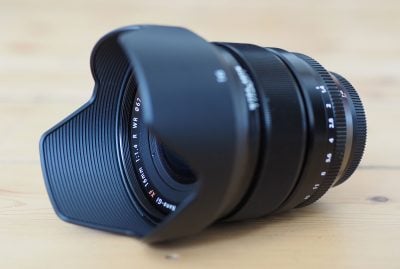Fujifilm XF 16mm f1.4 review
-
-
Written by Gordon Laing
In depth
The Fujifilm XF 16mm f1.4 is a bright wide-angle prime lens for the X-series of mirrorless cameras. Announced in April 2015, it delivers fixed coverage equivalent to 24mm to capture comfortably wider views than 28mm, without the distortion of shorter, ultra-wide focal lenses. This balance makes 24mm one of the most popular focal lengths of any system.
Making the XF 16mm more useful is its bright focal ratio of f1.4, allowing you to maintain hand-holdable shutter speeds in in low light without having to bump-up the sensitivity. It also allows shallow depth-of-field effects, particularly at close range when used at the minimum focusing distance of 15cm. It’s also possible to switch it to manual focus by pulling down the focusing ring which in turn reveals distance and depth-of-field scales. Completing the impressive specification is a manual aperture ring and sealing against dust and moisture, although like other Fuji primes to date it does not feature optical stabilisation.
The XF 16mm f1.4 is without a doubt a desirable lens for landscape and architectural shooters, but many of them will already own the XF 10-24mm ultra-wide zoom. The big question then is how they compare, not just in sharpness, but also in terms of close focusing and potential depth of field. In my in-depth review I’ll compare all these aspects and help you choose the right lens.
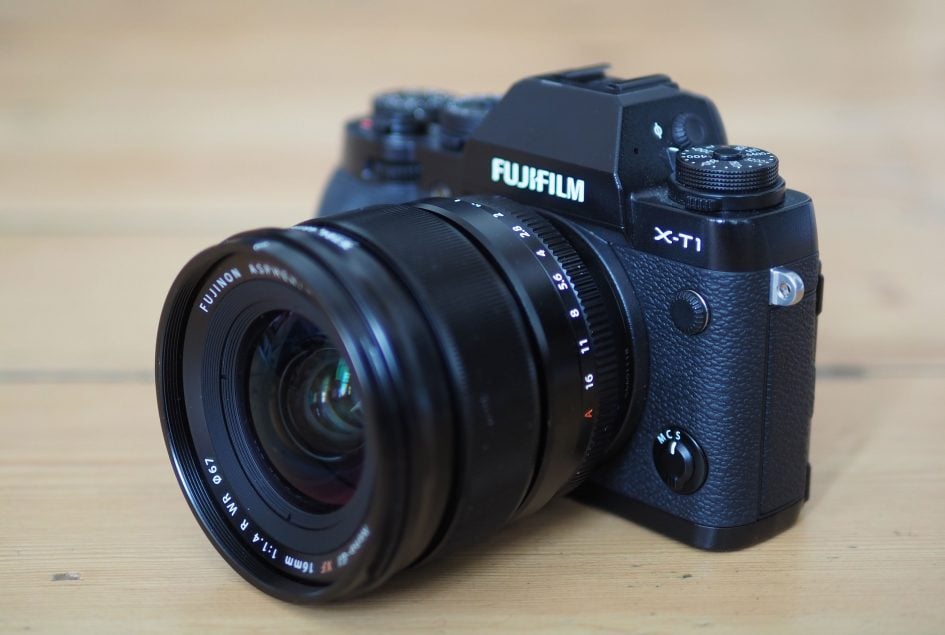
Fujifilm XF 16mm f1.4 design and build quality
With its short focal length and bright aperture, it’s not surprising to discover the XF 16mm f1.4 is the most substantial of the Fujifilm wide prime lenses. Measuring 73mm in length and the same in maximum diameter, it’s noticeably larger than the 14mm f2.8 and 35mm f1.4, and at 375g, it’s heavier too. To put it in perspective, it’s virtually the same size as the XF 56mm f1.2 telephoto prime, and only slightly lighter.
That said, as owners of the 56mm know, this hardly makes it unwieldy, although like that lens it does feel most comfortable on the larger of the X-series bodies, such as the XT1 and XT10 I tested it with. I’ve pictured it below, alongside the XF 10-24mm f4 zoom which is 5mm wider and 14mm longer.
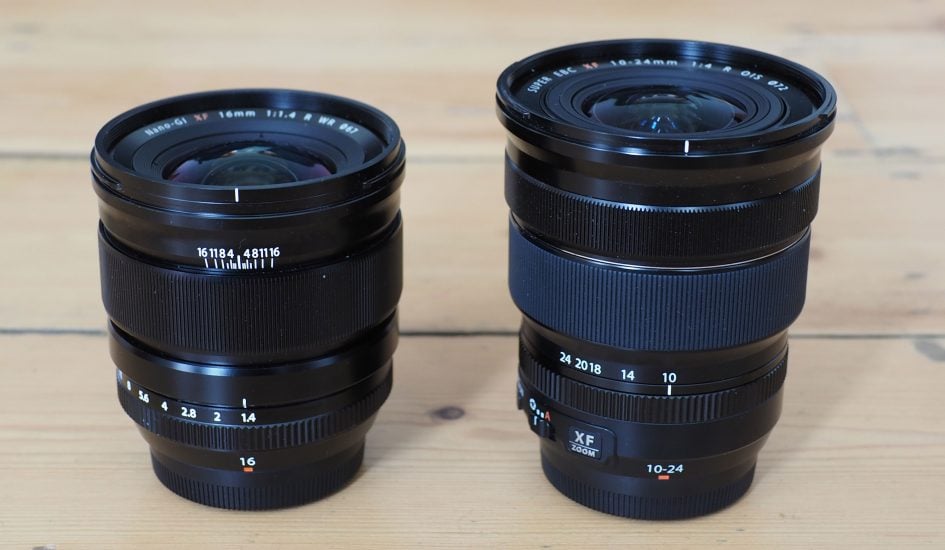
The XF 16mm joins the recent XF 90mm f2 and XF 35mm f2 to become the third weather-sealed prime lens, which includes a rubber gasket at the lens mount. I used it and the weather-sealed XT1 in drizzle with no ill-effects, although I should add I’ve had the unsealed XF 10-24mm in steady drizzle and it survived.
The XF 16mm f1.4 body employs two rings: a manual aperture dial at the lens mount-end of the barrel with numbered focal ratios from f1.4 to f16 and A, and a thick manual focusing ring towards the front of the barrel. The focusing ring can be pushed outwards to activate autofocus or pulled back to enable manual focus. When pulled back it reveals focus distance marks on the barrel from 15cm to infinity with an almost 180 degree throw and locks to prevent it turning beyond either extreme. You can see it below left with the focus ring pushed-up and below right with it pulled-down to reveal the focus distance marks.
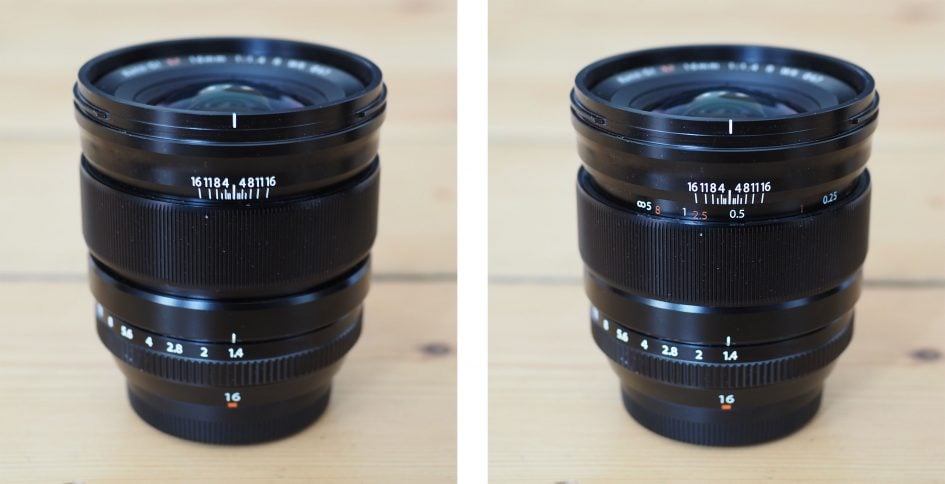
In this respect it looks and initially feels like a mechanically-linked focusing system, but like other Fuji lenses, it’s a fly-by-wire system with motor-assistance. Set the lens to manual focus and as you turn the ring, motors will do the actual adjusting of the optics for you. But at least if set manually, the lens keeps its focusing distance should the camera power down and back up again, so it is similar in practice to a full mechanical system. Meanwhile the ring itself turns smoothly and coupled with the excellent focusing assistance on the X-bodies, provides a good manual focusing experience.
Autofocus speed feels similar to other Fujifilm primes – as such you’re looking at around a second to a second and a half before it locks-on and you can faintly feel and hear the motors in action. In contrast the XF zooms focus a little faster and more quietly. I found the XF 16mm f1.4 focusing speed to be adequate for general-use but it was too slow for continuous AF – not that you’re likely to use it a great deal in a continuous AF environment though.
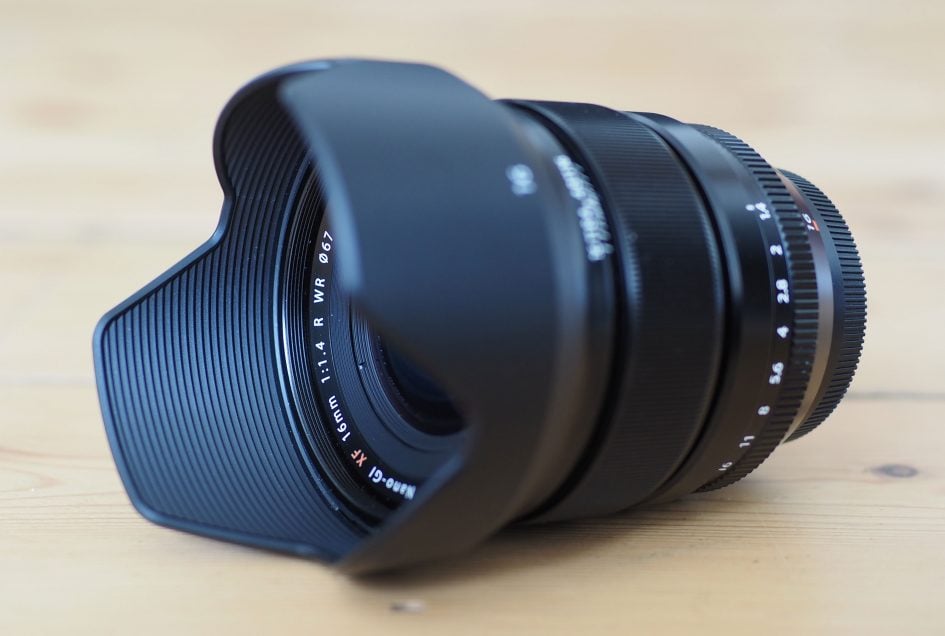
Finally, the XF 16mm f1.4 is supplied with a substantial lens hood that clips onto the end of the barrel with a bayonet mount. It provides good protection for the front element, not just from flare but also inclement weather or gracing knocks. Meanwhile a 67mm thread is provided for filters. I used it with my LEE Seven5 Big Stopper without vignetting.
Fujifilm XF 16mm f1.4 optical construction
The XF 16mm f1.4 is the second shortest prime in the current X-series lineup, delivering fixed coverage equivalent to 24mm. Only the 14mm is wider, with its 21mm equivalent coverage, albeit with a much slower f2.8 focal ratio.
Everyone has their favourite focal lengths, but 24mm equivalent is definitely up there as one of mine. Comfortably wider than 28mm for more dynamic compositions, but without the obvious distortion of ultra-wide options. I’ve pictured its coverage below in my usual view of Brighton’s sea front from the Pier, and below that for comparison, examples from the same position taken with the XF 10-24mm at its shortest and longest focal lengths. Clearly the XF 16mm sits roughly in the middle of that range.

Above: Fujifilm XF 16mm (24mm equivalent)

Above left: Fuji XF 10-24mm at 10mm (15mm equiv), above right: Fuji XF 10-24mm at 24mm (36mm equiv)
The maximum aperture of the XF 16mm is f1.4, matching the 23mm f1.4 and 35mm f1.4, and making it two stops brighter than the 14mm f2.8. Only the XF 56mm f1.2 is brighter in the range.
Thanks to its very well-corrected optics, the lens is surprisingly usable wide-open as this example below shows. This allows you to shoot in low light without having to bump-up the ISO to combat potential camera shake. Handy since like the other primes in the XF system, there’s no optical stabilisation here.

Above: Fujifilm XF 16mm at f1.4
The closest focusing distance of 15cm also means macro photography is possible and again thanks to the bright f1.4 focal ratio, it’s possible to achieve shallower depth-of-field effects than you might think. Thanks also to the electronic shutter on the XT1 and XT10 allowing speeds up to 1/32000, it’s also possible to deploy the f1.4 aperture in broad daylight. Here’s a selection of images at or near to the closest focusing distance.



At this point, you may be wondering how the potential for close-ups and blurring compares with some other lenses. I think many photographers considering the XF 16mm f1.4 will already have or also be weighing it up against the XF 10-24mm f4, and it certainly makes for an interesting comparison in terms of potential depth of field.
To find out how they compared, I shot a number of versions of the scene below in Brighton’s Bison Beer shop. In the first example I set the XF 10-24mm to 16mm, opened its aperture to the maximum f4 and positioned it at its closest focusing distance of 24cm. I then swapped the lens for the XF 16mm f1.4 and took the same photo from 24cm, but with the larger aperture of f1.4. The 16mm shot is below left and the 10-24mm shot is below right.

Above left: Fuji XF 16mm at f1.4, above right: Fuji XF 10-24mm at 16mm f4. Both from 24cm
In the example above, there’s clearly no contest. When you have two lenses with the same effective focal length at the same distance, the one with the larger aperture will always deliver the shallower depth of field, and the difference between f1.4 and f4 is significant.
But that’s not the end of the story. The XF 16mm can focus almost 50% closer at 15cm, further accentuating the shallow depth of field and you can see an example of that below left. But while the XF 10-24mm can’t focus closer than 24cm, nor open its aperture larger than f4, it can zoom-in further. So below right you can see how it looks at 24cm and f4, but at a longer focal length of 24mm, which again accentuates the shallow depth of field effect.

Above left: Fuji XF 16mm at f1.4 from 15cm, above right: Fuji XF 10-24mm at 24mm f4 from 24cm
In the example above, the XF 16mm f1.4 still wins with its unbeatable combination of close focusing distance and large maximum aperture. But it is important to see how you can improve on the first example from the XF 10-24mm by zooming-into its longer focal length. Indeed it’s revealing to see how zooming to 24mm has allowed the XF 10-24mm to deliver a result that’s much closer to the first example from the XF 16mm at f1.4 when both are positioned at the same focusing distance.
So when weighing up these two cameras for macro performance, the XF 16mm has the benefit of closer focusing and larger aperture, but the XF 10-24mm has the benefit of a longer focal length. In practice, the XF 16mm will only take a decisive lead in macro photography if you exploit its closer focusing distance.
Depth of field is only one effect of adjusting the aperture. Closing the aperture down can reveal the shape and number of aperture blades, producing diffraction spikes on point sources of light like the Sun or bright streetlamps on a distant city skyline.
The XF 16mm f1.4 features nine aperture blades (versus seven on the XF 14mm and XF 10-24mm) which ensure the rendering remains well-behaved as you close the aperture down, and at the smallest focal ratio of f16 you can achieve 18 attractive diffraction spikes as seen below on this image of the setting Sun. The Lens Modulation Optimiser profiling also ensures the image doesn’t become too soft at f11 or f16.

Above: Fujifilm XF 16mm at f16
As for the optical construction, the XF 16mm f1.4 employs 13 elements in 11 groups, including two aspherical and two extra low dispersion elements.
Now it’s time to check out how the lens performs in terms of sharpness across the frame! Check out my Fuji XF 16mm f1.4 sharpness results, or skip to my Fuji XF 16mm f1.4 sample images or back to my verdict!
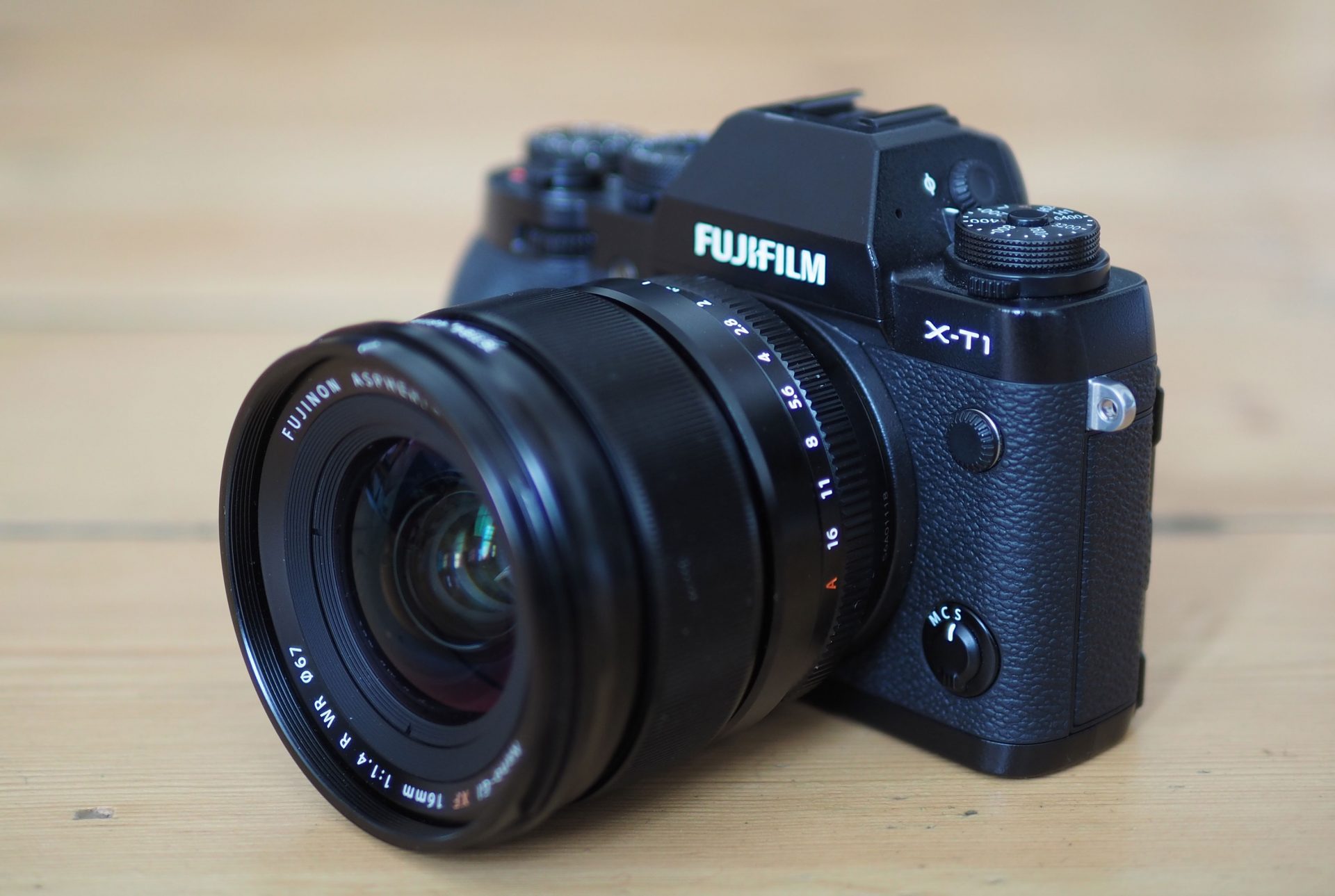
 The Fujifilm XF 16mm f1.4 is a high quality wide-angle prime lens for Fujifilm X-series bodies. The 24mm equivalent field of view is an eternal favourite with landscape and architectural photographers, capturing wider and more dynamic compositions than a 28mm, but without the distortion of an ultra-wide. The optical quality is very good, and while the sharpness may peak at f5.6, it performs very respectably even wide-open at f1.4. Anyone shooting outdoors in inclement conditions will also appreciate the weather-sealing. If you're into wide-angles, the XF 16mm f1.4 is an obvious choice, but weigh it up carefully with the XF 10-24mm f4 OIS zoom which may be three stops darker and lack weather-sealing, but boasts optical stabilisation and a broader range that zooms wider and longer.
The Fujifilm XF 16mm f1.4 is a high quality wide-angle prime lens for Fujifilm X-series bodies. The 24mm equivalent field of view is an eternal favourite with landscape and architectural photographers, capturing wider and more dynamic compositions than a 28mm, but without the distortion of an ultra-wide. The optical quality is very good, and while the sharpness may peak at f5.6, it performs very respectably even wide-open at f1.4. Anyone shooting outdoors in inclement conditions will also appreciate the weather-sealing. If you're into wide-angles, the XF 16mm f1.4 is an obvious choice, but weigh it up carefully with the XF 10-24mm f4 OIS zoom which may be three stops darker and lack weather-sealing, but boasts optical stabilisation and a broader range that zooms wider and longer.



